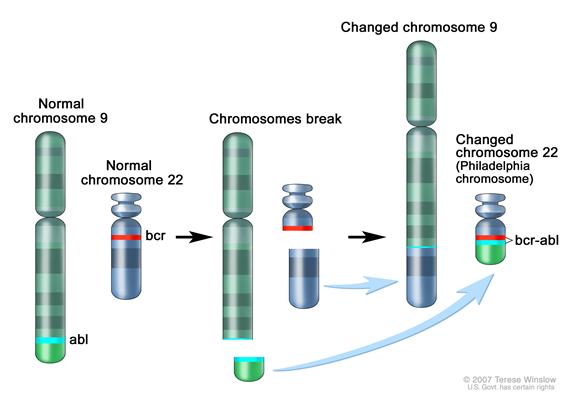Chronic myelogenous leukemia other diagnostic studies
|
Chronic myelogenous leukemia Microchapters |
|
Differentiating Chronic myelogenous leukemia from other Diseases |
|---|
|
Diagnosis |
|
Treatment |
|
Case Studies |
|
Chronic myelogenous leukemia other diagnostic studies On the Web |
|
American Roentgen Ray Society Images of Chronic myelogenous leukemia other diagnostic studies |
|
FDA on Chronic myelogenous leukemia other diagnostic studies |
|
CDC on Chronic myelogenous leukemia other diagnostic studies |
|
Chronic myelogenous leukemia other diagnostic studies in the news |
|
Blogs on Chronic myelogenous leukemia other diagnostic studies |
|
Directions to Hospitals Treating Chronic myelogenous leukemia |
|
Risk calculators and risk factors for Chronic myelogenous leukemia other diagnostic studies |
Editor-In-Chief: C. Michael Gibson, M.S., M.D. [1]
Overview
Biopsy
A bone marrow biopsy is often performed as part of the evaluation for CML, but bone marrow morphology alone is insufficient to diagnose CML.
Philadelphia chromosome
Ultimately, CML is diagnosed by detecting the Philadelphia chromosome. This characteristic chromosomal abnormality can be detected by routine cytogenetics, by fluorescent in situ hybridization, or by PCR for the bcr-abl fusion gene.

Controversy exists over so-called Ph-negative CML, or cases of suspected CML in which the Philadelphia chromosome cannot be detected. Many such patients in fact have complex chromosomal abnormalities which mask the (9;22) translocation, or have evidence of the translocation by FISH or RT-PCR in spite of normal routine karyotyping.[1] The small subset of patients without detectable molecular evidence of bcr-abl fusion may be better classified as having an undifferentiated myelodysplastic/myeloproliferative disorder, as their clinical course tends to be different from patients with CML.[2]
References
- ↑ Savage DG; Szydlo RM; Goldman JM (1997). "Clinical features at diagnosis in 430 patients with chronic myeloid leukaemia seen at a referral centre over a 16-year period". Br J Haematol. 96 (1): 111–116. PMID 9012696.
- ↑ Tefferi A, Thiele J, Orazi A, Kvasnicka HM, Barbui T, Hanson CA, Barosi G, Verstovsek S, Birgegard G, Mesa R, Reilly JT, Gisslinger H, Vannucchi AM, Cervantes F, Finazzi G, Hoffman R, Gilliland DG, Bloomfield CD, Vardiman JW (2007). "Proposals and rationale for revision of the World Health Organization diagnostic criteria for polycythemia vera, essential thrombocythemia, and primary myelofibrosis: recommendations from an ad hoc international expert pane". Blood. 110 (4): 1092–1097. PMID 17488875.


